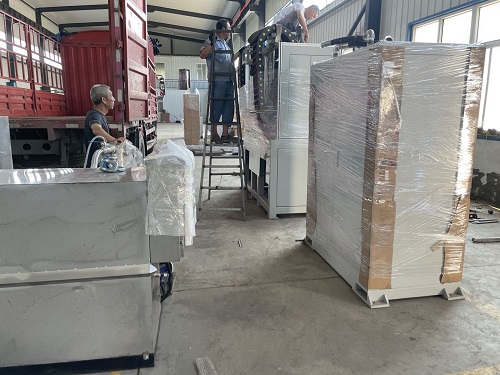Universal hardening machine tool for horizontal shaft gear
Induction hardening is a method of quickly and selectively hardening the surface of a metal part. A copper coil carrying a large amount of alternating current is placed near (not in contact with) the part. Eddy currents and hysteresis losses generate heat at and near the surface. Hardening, usually water-based, with the addition of polymers, etc., is applied directly to the part or by immersion. This transforms the structure to martensite, which is much harder than the previous structure.
There is a direct correlation between hardness and wear resistance. Assuming that the initial state of the material is annealed or treated to softer conditions, the wear resistance of the part increases significantly with induction hardening.
Compressive stresses (often considered a positive property) are due to the hardened structure near the surface occupying slightly more volume than the core and previous structure.
Typical surface depths of 0.030" - 0.120" are on average deeper than processes such as carburizing, carbo-nitriding and various forms of nitriding performed at subcritical temperatures. For certain items, such as shafts or parts that remain useful even after extensive material wear, the shell depth may be as much as ½" or greater.
Areas remain soft after welding or after machining - few other heat treatment processes can achieve this.
The most common steel used for induction hardening parts is 1045, which is easy to machine, low cost, and can be induction hardened to 58 HRC+ due to its nominal carbon content of 0.45%. It also has a relatively low risk of cracking during processing. Other popular materials used for this process are 1141/1144, 4140, 4340, ETD150 and various cast irons.

Since the part-to-coil coupling distance is critical to heating efficiency, the size and profile of the coil must be carefully selected. While most processors have a library of basic coils to heat round shapes such as shafts, pins, rolls, etc., certain projects may require custom coils, sometimes costing thousands of dollars. For low-volume projects where new coils must be built, coil and tooling costs often make the process impractical.
This is due to rapid heating and hardening, and the tendency to create hot spots at features/edges, e.g., keyways, recesses, cross holes, threads. (If you have any concerns, please contact an AHT representative.)
It is true that distortion levels tend to be greater than processes such as ion or gas nitriding due to rapid heating/quenching and the resulting martensitic transformation. That said, induction hardening may produce less distortion than conventional heat treating, especially when it is applied only to selected areas.
Since induction hardening processes do not typically involve diffusion of carbon or other elements, the material must contain sufficient carbon and other elements to provide the hardenability to support martensitic transformation to the desired hardness level. This typically means a carbon content in the range of 0.40%+, yielding a hardness of 56 - 65 HRC. Steels such as 1008, 1010, 12L14, 1117, etc. are usually not used because of the limited increase in achievable hardness.
With the features of high quality, environmental protection, energy saving and high efficiency, Chaochang brand induction heating equipment has been widely used in machinery, metallurgy, mining, building materials, automobile parts manufacturing, fully meet the needs of steel pipe seam welding, H-beam welding, steel pipe annealing, metal heat treatment, smelting, forging, quenching and tempering,etc. Please click here to leave your questions and we will give you a satisfying answer.
Baoding Chaochang Electromechanical Co., Ltd.
Copyright © Baoding Chaochang Electromechanical Co., Ltd. All Rights Reserved | Sitemap
